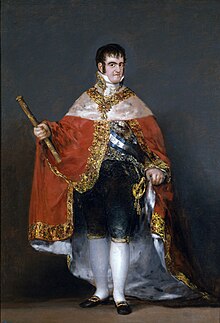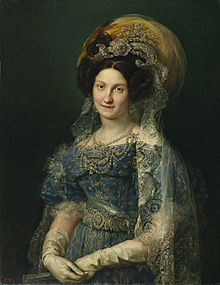Ferdinand VII (Spain)
Ferdinand VII ( Spanish Fernando VII ; born October 14, 1784 in San Ildefonso ; † September 29, 1833 in Madrid ) was King of Spain in 1808 and from 1813 to 1833. He declared the liberal constitution of Cadiz null and void and exercised most of it an absolutist style of rule during his reign.
Life
Ferdinand VII was the eldest surviving child of Maria Luise of Parma , who was recognized as his son by her husband Charles IV of Spain . The Queen's confessor, Fray Juan Almaraz, claims in his will that Marie Luise admitted in articulo mortis that "none, none of their children, none of the legally valid marriage." The most likely candidate for paternity is the favorite Manuel de Godoy , under whose direction Ferdinand was brought up courtly.
On October 6, 1802 he married Princess Maria Antonia of Naples and Sicily , a daughter of the future King of the Two Sicilies , Ferdinand I , who died in 1806.

Concerned that his parents would be excluded from the line of succession, partly influenced by the discontented grandees under the leadership of Pedro Alcántara de Toledo , Duke of El Infantado , and the priest Juan Escoiquiz , his teacher and confessor, Ferdinand made connections with François de Beauharnais , the then French envoy in Madrid , to break the dominant position of Prime Minister Godoy, who he hated. He himself entered into correspondence with Napoleon I , whom he informed in a letter dated October 11, 1807 that he wanted to marry Lucien Bonaparte's eldest daughter . These negotiations were betrayed (possibly by Beauharnais himself) and Lucien also refused to consent. Ferdinand was arrested in El Escorial on October 18, 1807 and accused of high treason in a royal manifesto on October 30, whereupon he submitted and betrayed his accomplices.
When the uprising in Aranjuez broke out on March 18, 1808 as a result of the news of the royal family's escape plan and Charles IV renounced the crown in favor of Ferdinand on March 19, Ferdinand was proclaimed the new king with jubilation by the people. A few days later, however, at Murat's instigation, Charles IV declared his renunciation of the throne to be forced. Napoleon objected to Ferdinand's recognition as king, but invited him to a negotiation in Bayonne . There was Ferdinand after prolonged reluctance on May 6, the crown of his supposed father returned and placed himself under the protection of Napoleon, who gave him an annual pension of one million francs the Talleyrandsche Castle Valençay instructed as whereabouts. De facto, however, this was a capture of the royal family by Napoleon.

Ferdinand spent more than five years on Valençay in the company of his brother Don Carlos . In Spain he became a symbol of the uprising against Charles IV, who was allied with Napoleon. It was not until the end of 1813 that Napoleon offered Ferdinand the crown again. On the basis of the Treaty of Valençay of December 11, 1813, Ferdinand returned to Spain in March 1814, where he was received with enthusiasm by the people. By a decree of May 4, he overturned the constitution of 1812 and established a bloody ecclesiastical and political reaction with inquisition and torture. In doing so, he restored absolutism in such an extreme form that it even lost the support of the other European monarchies. Liberal uprisings aimed at restoring the constitutional monarchy initially failed. The uprising of January 1820 forced Ferdinand to restore the Constitution of the Cortes from 1812 on March 7th . In the following years he had to share power with the various currents of the revolutionary movement. When absolutist violence was restored in Spain by the French invasion of 1823, Ferdinand returned to the old system.

On December 11, 1829, after the early death of his daughter from his second marriage, Ferdinand married for the fourth time, this time with his niece Maria Christina of Naples and Sicily , daughter of King Francis I of the Two Sicilies , who on October 10, 1830 the future Queen of Spain, Isabella II .
At the instigation of Queen Maria Christina, Ferdinand VII carried out the repeal of the Salic law, requested by the Cortes in 1822, on March 29, 1830 by means of a so-called pragmatic sanction , which restored the old Castilian cognatic succession and thus the possibility of a female succession to the throne. This decision contributed to destabilizing Spain for decades, as his brother Carlos saw this as the robbery of his claims to the throne and immediately after Ferdinand's death triggered the first of several Carlist Wars to drive Maria Christina and Isabella from the throne.
Seriously ill, the king transferred the management of state affairs to his wife in October 1832, whereupon a liberal system of government developed. The Carlist-minded minister Calomarde , who had the almost unconscious king sign a decree that repealed the pragmatic sanction of 1830, had to flee, and on December 31st Ferdinand declared this decree to have been fraudulently obtained. On January 4, 1833 he took over the government himself, but he died on September 29, 1833 and was buried in the pantheon of kings of the monastery El Escorial .
Marriages and offspring
- 1.) October 6, 1802: Maria Antonia of Naples-Sicily († 1806), daughter of the later King of the Two Sicilies Ferdinand I.
- 2.) September 29, 1816: Maria Isabella of Portugal († 1818), daughter of King John VI. from Portugal :
- Infanta Maria Isabella (born August 21, 1817 - † January 9, 1818)
- 3.) October 20, 1819: Maria Josepha of Saxony († 1829), daughter of Prince Maximilian of Saxony .
- 4.) December 11, 1829: Maria Christina of Naples-Sicily (1806–1878), daughter of King Francis I of the Two Sicilies , thus Ferdinand's niece:
- Infanta Isabella Maria (October 10, 1830 - April 9, 1904), later Queen Isabella II of Spain
- Infanta Luisa Fernanda (born January 30, 1832 - February 2, 1897), later Duchess of Montpensier
Others
On Jan. 19, 1815 presented the 1811 Ferdinand donated Ferdinand Order restores. King Friedrich Wilhelm III. of Prussia awarded Ferdinand on June 3, 1814 (No. 126 of the awards of Friedrich Wilhelm III.) the Order of the Black Eagle . The plant genus Ferdinanda Lag. From the daisy family (Asteraceae) is named after Ferdinand .
ancestors
| Philip V , King of Spain (1683–1746) | |||||||||||||
| Charles III King of Spain (1716–1788) | |||||||||||||
| Elisabetta Farnese (1692–1766) | |||||||||||||
| Charles IV. King of Spain (1748–1819) | |||||||||||||
| August III. , King of Poland. As Friedrich August II. Elector of Saxony (1696–1763) | |||||||||||||
| Maria Amalia of Saxony (1724–1760) | |||||||||||||
| Maria Josepha of Austria (1699–1757) | |||||||||||||
| Ferdinand VII King of Spain | |||||||||||||
| Philip V King of Spain (1683–1746) | |||||||||||||
| Philip Duke of Parma (1720–1765) | |||||||||||||
| Elisabetta Farnese (1692–1766) | |||||||||||||
| Maria Luise of Bourbon-Parma (1751–1819) | |||||||||||||
| Louis XV King of France (1710–1774) | |||||||||||||
| Marie Louise Élisabeth de Bourbon , Princess of France (1727–1759) | |||||||||||||
| Maria Leszczyńska (1703–1768) | |||||||||||||
literature
- Pamela Beth Radcliff: Modern Spain. 1808 to the Present. John Wiley & Sons, Hoboken NJ 2017.
Web links
Individual evidence
- ^ Zavala, José María: Bastardos y Borbones . Plaza & Janés Editores, Barcelona 2011, ISBN 978-84-01-38992-4 ( [1] ).
- ↑ Lotte Burkhardt: Directory of eponymous plant names - Extended Edition. Part I and II. Botanic Garden and Botanical Museum Berlin , Freie Universität Berlin , Berlin 2018, ISBN 978-3-946292-26-5 doi: 10.3372 / epolist2018 .
| predecessor | Office | successor |
|---|---|---|
| Charles of Bourbon and Saxony |
Prince of Asturias 1789–1808 |
Isabella of Bourbon and Bourbon-Naples-Sicily |
|
Charles IV Joseph Bonaparte |
King of Spain 1808 1813–1833 |
Joseph Bonaparte Isabella II |
| personal data | |
|---|---|
| SURNAME | Ferdinand VII. |
| ALTERNATIVE NAMES | Fernando VII (Spanish) |
| BRIEF DESCRIPTION | King of Spain (1814–1833) |
| DATE OF BIRTH | October 14, 1784 |
| PLACE OF BIRTH | San Ildefonso |
| DATE OF DEATH | September 29, 1833 |
| Place of death | Madrid |


